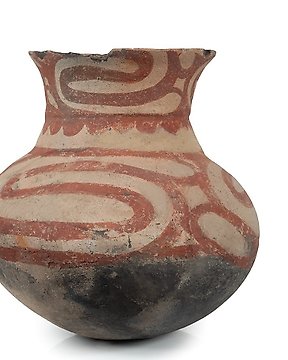
Bang-Chiang, Ταϊλάνδη, Terracotta Τερακότα Σφαιρικό δοχείο βάζου. 2500 π.Χ. - 300 μ.Χ. 30 cm Υ. Με TL test
Αρ. 82993029

Αρ. 82993029

Female Sarcophagus bust.
Canaanite, 1400 to 1300 BC
Terracotta
Height 55 cm
PROVENANCE: Private collection Biarritx, France. 1970 - 1980.
CONDITION: Good condition.
DESCRIPTION:
The discovery of anthropoid pottery coffins with Egyptian-looking appearances in excavations throughout Israel has generated a great deal of scholarly attention. The coffins, cylindrical and of considerable size, were produced using the coiling technique. Their upper parts are fitted with a lid exhibiting a human face and arms in a variety of styles. The lid was cut from the coffin before it had completely dried, allowing it to fit the coffin perfectly. Through the opening that was created, the body of the deceased, along with funerary gifts, was inserted. Some of the lids and coffins still bear traces of paint: the face was painted white, the lips or cheeks red, and the eyes black or yellow. Each of the differently designed lids exhibits at least a few of the following features: a wig, a lotus flower on the forehead, eyes, eyebrows, a nose, a mouth, a chin, an “Osiris” beard, cheeks, ears, arms, and hands. These details were achieved by the application of additional clay to the smooth lid or by marking. A protrusion at the lower part of the coffin usually represents feet; it is reasonable to assume that this also made it possible to stand the coffin upright during production. In rare cases, realistic feet are depicted.
To date, 130 complete and fragmentary anthropoid coffins have been found within the borders of Canaan: For example, in archeological excavations at Deir el-Balah (south of Gaza), only four tombs containing such coffins were unearthed. Besides these, 33 coffins and an additional 11 lids are to be found in the Israel Museum Collection (most originally in the Dayan Collection and presumably from Deir el-Balah). A coffin in the collection of the Hecht Museum, Haifa, and lids in the Bible Land Museum, Jerusalem, all probably came from the Deir el-Balah excavation.
The Canaanite culture, in its forms of burial and funerary rituals presented remarkable similarities with the Egyptian ones. Here we show an anthromorphic sarcophagus lid, in terracotta, with a synthesized and geometrized face, crowned with a semicircular hairstyle with incised notches. According to Canaanite beliefs, when the physical body dies, the npš (usually translated as "soul") is transferred from the body to the land of Mot. The bodies of the dead were buried with grave goods and offerings of food and drink were made to them so that they would not disturb the living. The terracotta boxes were usually surrounded by canopic vessels and vases, in an arrangement similar to the burials of Egyptian nobles, who were prepared for the transition to the afterlife.
The Canaanite religion is the name given to the group of ancient Semitic religions practiced by the Canaanites who lived in the ancient Mediterranean Levant from at least the Early Bronze Age to the first centuries of the Christian Era.
BIBLIOGRAPHY:
- Pharaoh in Canaan: The Untold Story. The Israel Museum. Jerusalem. 2016. pág. 96 - 100.
Notes:
The seller guarantees that he acquired this piece according to all national and international laws related to the ownership of cultural property. Provenance statement seen by Catawiki.
The piece includes authenticity certificate.
The piece includes Spanish Export License (Passport for European Union) - If the piece is destined outside the European Union a substitution of the export permit should be requested. This process could take between 1 and 2 months.
Πώς να πραγματοποιήσετε αγορές στην Catawiki
1. Ανακαλύψτε κάτι ιδιαίτερο
2. Υποβάλετε την κορυφαία προσφορά
3. Πληρώστε με ασφάλεια